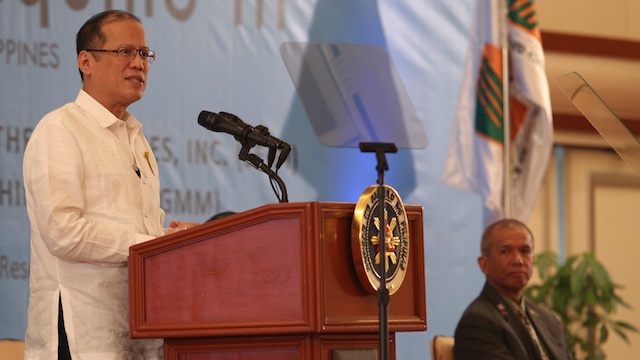SUMMARY
This is AI generated summarization, which may have errors. For context, always refer to the full article.

MANILA, Philippines – President Benigno Aquino III gave assurances on Monday, October 21, the government would continue providing relief efforts to earthquake victims in Central Visayas, even if the calamity fund is running dry.
Aquino said the amount requested by government agencies to restore normalcy in the affected provinces has exceeded the remaining calamity fund and the contingency fund. The government would use savings to close the gap.
According to Aquino, there remains P176 million in calamity fund and P824 million in contingency fund – a total of P1 billion. The Department of Public Works and Highways (DPWH), however, had requested P7 billion to restore damaged bridges.
The Executive has about P20 billion in savings, the President told reporters.
“Bottom line is, there’s a request for P7 billion and savings we have about P20 billion. Current calamity [fund] has P176 [million] remaining balance, contingency has P824 million, so that’s roughly about a billion – so it’s not enough. The balance, we can source from the savings to augment both line items, which is the contingency and the calamity,” Aquino said.
The President said the conflict between government troops and Muslim rebels in Zamboanga City and recent storms had drained the calamity fund, but said the government would continue to provide assistance to victims for at least the next two weeks.
On Tuesday, October 15, a 7.2-magnitude earthquake hit Sagbayan, Bohol, and was felt across the Visayas and some parts of Mindanao. The death toll is now at 186, while the cost of damage to infrastructure is now pegged at P867 million.
Figures released by the government previously put the number of affected people to as high as 3.54 million.
Money for victims
Meanwhile, government agencies continue to serve affected communities as focus has shifted from rescue to relief efforts.
According to Division Chief of the Operations Division of the National Disaster Risk Reduction Management Council Major Rey Balido, the NDRRMC, through the Office of Civil Defense (OCD), will distribute “relief or immediate financial assistance” to victims of the earthquake who were killed or injured in the quake.
“For every person that died, his or her family will receive P10,000 as immediate financial assistance, and for those who were hurt, they will receive P5,000 each,” he told reporters in Malacañang.
Aside from cash, the Department of Social Welfare and Development (DSWD) is also occupied with distribution and preparation of food packs.
Aquino said over a hundred thousand food packs have already been distributed to 30,000 families that were affected, emphasizing “there are more food packs than there are supposed to be directly-affected families.”
Balido said the DSWD is also giving out non-food items.
“As of now, a total of P6.9 million consisting of food packs, water, and tents have been provided to all municipalities in the province of Bohol. The efforts are ongoing,” he said.
The DSWD is set to purchase another P103 million worth of food items and water, which will be sufficient for 5 days and ensure victims don’t have to line up for supplies every other day.
Challenges
But Aquino admitted there are still challenges for the government in relief distribution – primarily aftershocks.
He said residents are unwilling to return to their homes in fear of more tremors, so the government is needing to take care of more families even if they were not directly affected.
“Regardless on whether there is damage or not, the general population – apart from the 30,000 [directly affected] – feel they aren’t safe in their homes. So we were not able to compute [them into the estimate],” he said. “We were not able to prepare for the others whose houses were not directly damaged.”
“So again, if you have a hundred thousand [food packs] that will be distributed already, it’s supposed to take care of the 30,000 directly-affected families, so it’s more than enough. But the others, they feel they should be included in the affected number because they feel the aftershocks, so that’s the issue.”
Aftershocks have also made it difficult to resort electricity in some areas, added Aquino, because “households themselves are asking that to check the conditions of their houses for energizing them.”
“Those who are doubting the structural integrity of their house, [they’re concerned] the wires would break, they might get electrocuted, they don’t want their homes energized first,” he said.
Aquino said power has been restored in 11 towns in Bohol, and 77.74% of all barangays have been re-energized.
Additionally, Aquino said while he was “given the reassurance that there is no community that is not being taken care of,” he admitted “there’s a possibility that upland communities without communication are having difficulty transmitting their calls for help.”
To help them, DSWD National Capital Region Operations Center chief Resty Macuto said, choppers are on standby to directly bring supplies to areas that are unreachable, the moment they get alerts for help.
NDRRMC chief Eduardo del Rosario also gave assurances the amount of relief goods provided by the government are sufficient, but admitted the main problem is distribution.
“Distribution really is the [problem]. That’s where we’re having a bit of a problem because we need the manpower. But now that the road nets are getting better and we’re using sea vessels and aircrafts, it’s improving,” he said. “Let’s not worry because the national and local government are committed to helping our countrymen.”
Del Rosario also brushed off accusations that relief distribution is tainted with politics and that barangay chairmans and mayors are keeping them stocked rather than giving them to constituents.
He encouraged locals to alert the NDRRMC of these concerns so regional agencies and the provincial government could look into their complaints. – Rappler.com
Add a comment
How does this make you feel?
There are no comments yet. Add your comment to start the conversation.